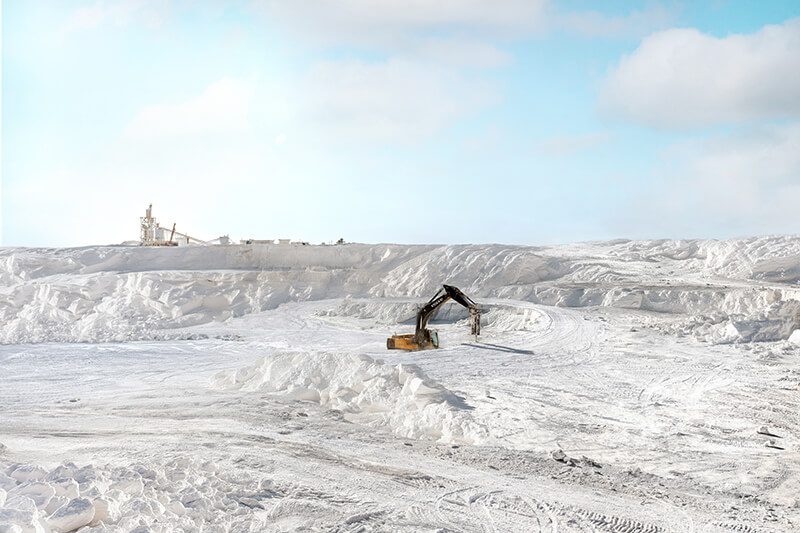In industrial innovation, most of the attention goes to robots, AI, and automation software. Yet, in many manufacturing-heavy sectors, some of the biggest efficiency gains come from something far less glamorous: fillers and functional powders hidden inside everyday materials. One of the quiet winners in this space over the past few years has been coated calcium carbonate, a material that sits at the intersection of chemistry, process engineering, and cost optimization.
From automotive parts and cables to paints, plastics, and masterbatch, coated calcium carbonate is increasingly part of the “invisible infrastructure” of modern manufacturing – lowering costs, improving performance, and helping companies meet stricter sustainability and regulatory targets.
Why Functional Fillers Matter More In 2025 Than Ever
Manufacturers in 2025 are operating under a different set of constraints than they were even five years ago. Input costs are volatile. Supply chains are more fragile. ESG reporting is no longer optional. At the same time, customers expect lighter, stronger, and more durable products – often at the same or lower price.
This is where functional fillers move from being a commodity line item to a strategic lever. When used correctly, engineered fillers can:
- Reduce raw polymer consumption without compromising performance
- Improve processability and reduce cycle times in extrusion and injection molding
- Enhance surface finish, opacity, and mechanical properties
- Support compliance with stricter standards around recyclability and carbon footprint
Coated calcium carbonate belongs exactly in this category: a “lever” that plant managers and process engineers can pull to improve margins and stability without redesigning an entire product portfolio.
What Makes Coated Calcium Carbonate Different
Traditional (uncoated) calcium carbonate has been used for decades as a filler in plastics, coatings, paper, and construction materials. It is abundant, relatively low cost, and well understood. However, in many polymer and high-performance applications, untreated calcium carbonate has limitations: poor dispersion, weak compatibility with hydrophobic polymers, and negative effects on mechanical properties at higher loadings.
By introducing a surface treatment – typically fatty acids or other coupling agents – the behavior of the filler changes dramatically. This is the core value of modern Coated Calcium Carbonate used in demanding industrial applications. Surface-modified particles exhibit:
- Better compatibility with polymer matrices (PP, PE, PVC and others)
- Improved dispersion, minimizing agglomeration and visible defects
- Enhanced mechanical properties at comparable or higher loading levels
- Reduced viscosity and improved flow, enabling energy savings during processing
For manufacturers competing on both cost and performance, that combination is compelling. Instead of choosing between lower material costs and higher product quality, coated calcium carbonate often enables an “and”: cost optimization and performance improvement.
The Productivity Impact On Plastics And Masterbatch Producers
Plastics converters and masterbatch manufacturers have been early and enthusiastic adopters of coated fillers because the ROI shows up in several parts of their profit and loss statement at once.
First, there is the direct material cost effect. Substituting a portion of virgin polymer with a high-performance mineral filler is one of the most time-tested ways to reduce cost per kilogram. With well-engineered Coated Calcium Carbonate the substitution can often be pushed further than with uncoated grades because mechanical properties remain within specification.
Second, there is the processing benefit. Many processors report lower melt viscosity and smoother extrusion when using optimized coated grades. This translates into:
- Lower screw torque and reduced energy consumption
- Higher line speeds and better throughput
- Lower die build-up and fewer shutdowns for cleaning
Third, the quality dimension matters. Fewer surface defects, better color stability in masterbatch, and improved dimensional stability all have downstream impacts – fewer customer complaints, less scrap, and more predictable process windows during scale up.
A Hidden Contributor To Sustainability Targets
Sustainability conversations in manufacturing usually focus on renewable energy, recycling streams, or carbon accounting platforms. However, the material formulation level is just as important for companies chasing net-zero or low-carbon targets.
Coated calcium carbonate can contribute to sustainability in several ways:
- Lower polymer usage: Substituting polymers derived from fossil fuels with mineral content can reduce the overall carbon footprint of a product, especially in high-volume applications like film, pipes, and profiles.
- Extended product life: By improving mechanical properties or weathering resistance, functional fillers can help products last longer in the field, indirectly reducing environmental impact.
- Better recyclability profiles: In some formulations, optimized filler systems make recycling and reprocessing easier by stabilizing the material during multiple heat cycles.
In markets where regulations or large buyers demand environmental data at the SKU level, these incremental gains add up. Materials engineers are increasingly expected to understand not just the physics and chemistry of their formulations, but also the sustainability profile of each component.
Quality, Consistency, And The Role Of Specialized Producers
As demand grows, not all coated grades are created equal. Particle size distribution, surface treatment uniformity, whiteness, moisture control, and packaging standards can be the difference between a filler that unlocks productivity and one that creates new headaches on the production floor.
This is where the capabilities of a specialized Coated Calcium Carbonate factory become critical. Facilities that integrate high-purity raw material sourcing, modern coating technology, strict process control, and application-focused R&D are better positioned to supply consistent performance across batches. For manufacturers operating continuous lines, this consistency is not a luxury – it is a requirement to avoid unplanned downtime or off-spec production.
On the commercial side, long-term partnerships with a trusted Coated Calcium Carbonate factory can also de-risk supply chains. As more manufacturers move toward vendor consolidation and strategic sourcing, the ability of a filler supplier to co-develop formulations, provide technical support, and adapt grades to local regulatory or market constraints becomes a differentiator.
Industry 4.0 Meets Industrial Minerals
Industry 4.0 is usually associated with sensors, data lakes, and predictive maintenance. Yet, there is an interesting convergence happening between digitalization and industrial minerals as well. Leading producers and high-end users of coated calcium carbonate are increasingly:
- Instrumenting mills and coating lines with real-time monitoring for particle size and coating efficiency
- Feeding production and QC data into advanced analytics systems to predict and prevent variability
- Sharing application test data with customers to co-optimize recipes based on actual machine conditions
On the user side, formulation engineers can leverage historical process data – torque, throughput, defect rates – to fine-tune filler loading and grade selection. The result is a feedback loop where data from the shop floor directly influences which mineral grades are selected and how they are applied in new formulations.
Regional Dynamics: Why Local Production Still Matters
Even as supply chains globalize, the mineral fillers market retains a strong regional component. Transportation costs, local regulatory standards, and the availability of suitable raw carbonate deposits shape the economics of coated calcium carbonate in each geography.
For manufacturers in regions with growing plastics, cable, or coatings industries, local access to reliable coated filler production can become a competitive advantage. It can reduce lead times, buffer against currency volatility, and make just-in-time supply strategies more feasible. In markets under pressure from import competition, the ability to optimize formulations with locally produced functional fillers can also help preserve margins.
Beyond Cost: Designing For Performance From The Start
One of the most important shifts underway is a move from “after-the-fact” filler substitution to “designing in” coated fillers at the earliest stages of product development. Instead of viewing mineral content as something that is added to reduce cost after a formulation is built, forward-looking materials teams start with a clean sheet and ask:
- What mechanical, optical, and processing properties do we need?
- Which balance of polymer and mineral phases gives the best overall performance?
- How will this behave over the product’s full lifecycle – including recycling or end-of-life?
When coated calcium carbonate is considered at the concept stage, it becomes an integral part of performance engineering, not just a cost-saving tweak. This approach is particularly relevant in applications like:
- High-opacity, high-gloss films
- Rigid and flexible packaging
- Electrical cable insulation and sheathing
- Pipes and profiles where stiffness, impact, and processability must be balanced
Risk Management And Technical Support
As with any technical material, the benefits of coated calcium carbonate come with a learning curve. Switching grades or changing loading levels without adequate testing can introduce unexpected issues, from screw wear to color drift or warpage. That is why many manufacturers now treat their mineral suppliers as technical partners rather than transactional vendors.
Comprehensive technical support often includes:
- On-site or remote trials during line tests and scale-up
- Lab-based rheology, mechanical, and thermal analysis to benchmark different grades
- Guidance on dispersion, compounding parameters, and screw design
- Collaborative troubleshooting when a process variable drifts out of range
In an environment where line time is expensive and customer deadlines are tight, the ability to shorten that optimization cycle is highly valuable.
Looking Ahead: The Next Wave Of Functional Minerals
Coated calcium carbonate is part of a broader wave of engineered mineral solutions that will likely gain ground in the coming years. The next frontier is not just better individual fillers, but smarter combinations tailored to specific applications and processing technologies.
Expect to see more:
- Hybrid systems where coated calcium carbonate is combined with other functional fillers to tune properties precisely
- Application-specific grades, optimized for particular polymers, colors, or processing methods
- Data-backed selection tools that help engineers choose between several candidate fillers using objective performance and cost metrics
As pressure mounts to deliver lighter, stronger, more sustainable, and more affordable products, these “quiet” materials will continue to move closer to the center of strategic decision-making in manufacturing companies.
Conclusion
While advanced automation and AI dominate the headlines, much of the real leverage in manufacturing still comes from what happens inside the material itself. Coated calcium carbonate is a clear example of how a relatively simple idea – improving the interface between a mineral filler and a polymer – can unlock gains across cost, quality, sustainability, and process efficiency.
For manufacturers, the strategic question is no longer whether to use functional fillers, but how intelligently they are integrated into product design, sourcing, and operations. Those who treat materials engineering, and partners across the coated filler value chain, as a core capability rather than a procurement detail are likely to find themselves better positioned in an increasingly complex industrial landscape.
Read More From Techbullion



































